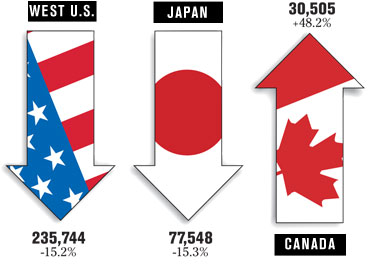STAR-BULLETIN / MARCH 2008
Japanese tourists enjoy a sunny day at Kuhio Beach Park. A new tourism report shows Japan visitor numbers dropped last month, as did those from the U.S. mainland.
|
|
Isle tourism braces for drop
A slumping economy and higher costs threaten the industry
STORY SUMMARY »
Hawaii visitor arrivals dropped just 7.6 percent in April in the wake of the high-profile closures of Aloha Airlines and ATA, which left the market with 15 percent fewer airline seats.
Visitor expenditures even managed a slight increase for the month, buoyed by longer stays and increased average daily spending, according to preliminary statistics released yesterday by the state Department of Business, Economic Development and Tourism.
But tourism officials and executives are seeing ominous signs ahead.
April travel to Hawaii from the western United States -- the state's largest visitor segment -- plunged 15.2 percent from year-ago levels, with traffic from California off 24.8 percent.
Officials are concerned that what they are seeing in those markets is not just a sign of a decrease in air capacity, but also the country's economic problems.
Advance bookings for the year have slowed, while cancellations have increased at isle hotels.
"There are still too many uncontrollable factors that we are facing with the economy, decreases in seats, higher airfares and fuel surcharges," said State Tourism Liaison Marsha Wienert.
FULL STORY »
Despite a 15 percent loss in airline capacity following the high-profile closures of Aloha Airlines and ATA, Hawaii visitor arrivals fell only 7.6 percent in April, while expenditures actually rose, albeit very slightly, compared with a year earlier.
ROUGH APRIL
Overall visitors traveling by air:
» Air seats: 736,079, down 15.7 percent
» Visitors: 538,428, down 7.6 percent
» Length of stay: 8.82 days, up 2.5 percent
» Daily spending: $185.60, up 5.9 percent
» Expenditures: $881.5 million, up 0.4 percent
Source: State Department of Business, Economic Development & Tourism
|
But that might be as good as it gets, for quite some time.
"It is just the start ... it's going to get worse," said Keith Vieira, senior vice president of operations for Starwood Hotels & Resorts Worldwide Inc. in Hawaii and French Polynesia.
Advanced bookings for the year have slowed, while cancellations have increased, he said. Further exacerbating the situation are higher operating costs at isle hotels, including energy and other related areas that have risen 6 percent to 9 percent, he added.
"So we have serious concerns," Vieira said. "Flat revenue and big increases in expenses -- this is not a good business path to be on."
Most alarming for tourism officials is that the U.S. market is down considerably from a year earlier, which is not just a sign of a decrease in airline capacity, but also the country's economic challenges, particularly in California, said Marsha Wienert, state tourism liaison. The amount of California visitors to Hawaii fell 24.8 percent last month.
"There are still too many uncontrollable factors that we are facing with the economy, decreases in seats, higher airfares and fuel surcharges," Wienert said.
KEY VISITOR MARKETS IN APRIL
A look at visitor travel from the U.S. West, Japan and Canada:  Source: State Department of Business, Economic Development & Tourism
|
|
April traffic from the western United States -- the largest visitor segment -- plunged 15.2 percent, while the high-spending Japanese market dove 15.3 percent, according to preliminary statistics released yesterday by the state Department of Business, Economic Development and Tourism.
In total, the domestic market was down 10.3 percent last month, with air arrivals from the eastern United States declining 5.1 percent.
April saw a culmination of all of the challenges Hawaii's bread-and-butter industry is facing and will be the base on which to judge the sector's performance moving forward, Wienert said.
Higher airfares combined with the latest round of fuel surcharges are expected to further dampen the industry's outlook for the year.
Both Japan Airlines and All Nippon Airways announced last week plans to boost their fuel surcharges on Hawaii flights by 43 percent on July 1, while American Airlines announced yesterday plans to cut back its Honolulu-Chicago route in September, and drop it completely in January.
While the amount of Canadian travelers jumped 48.2 percent last month, their numbers are still too small to make up the decrease in Japanese visitors.
Furthermore, Canadians traditionally aren't summer travelers, so will likely have minimal impact on what is normally the state's busiest tourist season, Vieira said.
"We've just got to find some way to stop the bleeding," he added.
A 5.9 percent increase in average daily spending to $185 per person in April compared to a year ago helped slightly boost air visitor expenditures by 0.4 percent from April 2007 to $881.5 million. The state saw a total of 538,428 air arrivals last month.
In addition, April travelers stayed longer in the isles, with average length of stay increasing 2.5 percent to 8.82 days.
Continued softness in the numbers of Japanese travelers and decreases in the domestic market were offset by increases in visitors from Australia, New Zealand, Europe and other parts of Asia.
Among the four largest islands, visitor spending in April was the strongest on Oahu, which saw a 9 percent increase in daily spending per person to $190 and a 6 percent rise in total expenditures to $420, despite a 6.8 percent decrease in arrivals. Maui is the only island that saw a decrease in per person per day spending, which fell 1.6 percent to $192, while expenditures declined 7.5 percent to $242. Maui's visitor count also dropped 9.6 percent.
Meanwhile, the number of cruise ship visitors fell a staggering 52.7 percent to 22,617 from 47,805 a year earlier. The average length of stay for all cruise visitors was 10.3 days, up from 9.52 days in April 2007.

